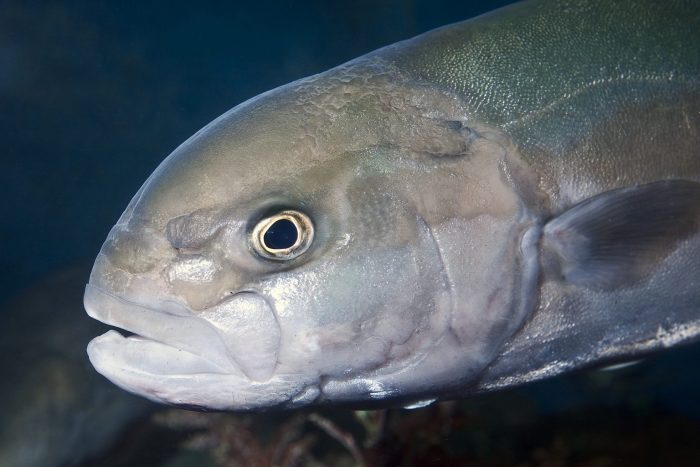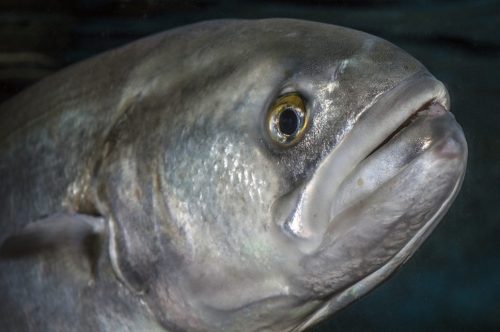
Bluefish are found along the East Coast from Maine to Eastern Florida. They arrive in North Carolina waters in early spring, while pursuing forage species including menhaden, anchovies and Atlantic silversides as they return to nearshore waters.
Bluefish are also known as blues, snappers, choppers and Taylor blues, according to the state Division of Marine Fisheries.
This species is known for hard strikes on fishermen’s bait, and a challenging fight to land after being hooked. Bluefish have a blue-green coloration along their back, and appear silver on their sides and bottom. They have a protruding, and powerful jaw full of sharp, serrated teeth.
“The dorsal fin is divided into two sections with the first section about half as long and high as the second fin. The second dorsal is just about the same size as the anal fin. The dorsal fin is also set-back on the top of the fish to reduce drag during quick bursts of speed to catch their prey. They have a deep, forked tail that resembles that of a tuna, another indicator this fish is designed for speed,” said David Behringer, Division of Marine Fisheries bluefish biologist.
“Bluefish live to be as old as 12 years of age. This species grows quickly, and can grow up to 31 pounds and be 39 inches in length. They are able to reproduce by the time they are 2 years old. The fish will typically be between 15 to 20 inches in length at that age,” he said.
In North Carolina waters, bluefish typically grow up to 34 inches in length and weigh 19 pounds. Recreational fishing citations are given for fish weighing 15 pounds or more.
“Females can lay between 400,000 to 2 million eggs per season, depending upon their size. This species will spawn several times during the spring and summer months,” he said.
The all-tackle world record bluefish was caught off Hatteras in 1972. This fish weighed 31 pounds, 12 ounces, and was landed on Jan. 30, 1972, by fisherman, James Hussey.
“This species exhibits a behavior known as a ‘blitz.’ Large concentrations of large fish viciously attack bait fish that are near the surface, and hit them from below. This mixes the water at the surface that looks something like a washing machine during its cleaning cycle. They are voracious feeders eating practically anything they catch in their path while eating,” Behringer said.
Having been in the water filming a school of these fish while they blitz-fed on Atlantic menhaden, I remembered a story that was told to me when I first started scuba diving some 30 years earlier. You do not want to be in the water with this fish while they feed – they will attack a diver and chew right through your wetsuit. Good thing I remembered that story after I jumped into the water to record the event.
“Bluefish are opportunistic feeders and will eat Atlantic menhaden, silversides, anchovies, Atlantic croaker, spot, squid, shrimp, lobster, crabs, worms, other bluefish and many other fish species,” said Behringer.
“Billfish, tuna and sharks are usually the only predators large and fast enough to catch large adult bluefish,” he said.

Managing Bluefish
This species is included in the North Carolina Fishery Management Plan for Interjurisdictional Fisheries. Management of bluefish was passed along to the 1989 Atlantic States Marine Fisheries Commission and Mid-Atlantic Fishery Management Council Fishery Management Plan for compliance requirements, which allows for an annually adjusted, state-by-state commercial quota system and recreational harvest limit to reduce fishing mortality.
“Several amendments have been added over time since the adoption of the bluefish fishery management plan,” said Chris Batsavage, special assistant for Councils, North Carolina Division of Marine Fisheries. “Amendment 1 allocated sector-based harvest percentages for the recreational catch of 83%, and commercial catch, of 17% of the fisheries.”
North Carolina is allocated 32.06% of the coastwide quota for bluefish, which in 2021 is about 887,000 pounds, he said.
“Each state is required to close its waters to fishing when its share of the commercial quota has been landed. The commercial quota can be increased if it is anticipated that the recreational fishery will not land their entire allocation for the upcoming year,” Batsavage explained.
Bluefish are mainly a recreational fishery, with sport fishermen catching about 87% of the total catch of this species up and down the East Coast.
“These fish will migrate depending upon the season up and down the coast, then anglers from Maine to Florida go after these animals near shoals, inlets, and rips, where they congregate to feed on big schools of food,” he added.
“The landings of recreational fishermen peaked at 163.76 million pounds in 1983, but fell sharply during the 1980s and 1990s. The average annual landings for sport fishermen between 2015 and 2019 was approximately 23 million pounds. The low point in fish being caught happened in 2018, when only 13.27 million pound of bluefish were caught along the entire East Coast,” said Batsavage.
Commercial landings of bluefish went down as well from 16.5 million pounds in 1981, to 7.3 million pounds in 1999. A state-specific catch limit was put in place in 2000.
“Since that time, commercial landings have generally declined from over 7 million pounds per year in 2009, and 2010 to less than 3 million pounds per year since 2018,” he said.
During the 2019 fishing season, the majority of bluefish were caught in North Carolina – 934,000 pounds. In New York, 595,000 pounds were caught, in Rhode Island 416,000 pounds, in Florida 214,000 pounds, in New Jersey 203,000 pounds and in Massachusetts 184,000 pounds, he said.
The recreational fishery is managed through how many fish you can have on your person, and boat in a single day, size limits and seasonal closures. Since recreational bluefish catch went down in recent years, the Mid-Atlantic Fishery Management Council and the Atlantic States Marine Fisheries Commission implemented a 15 fish possession limit in 2001.
North Carolina increased the bluefish bag limit to 15 fish in June of that year. In 2003, the North Carolina Marine Fisheries Commission adopted a rule whereby only 5 fish of the 15 fish bag limit can be greater than 24 inches in total length.
“In 2020, the Mid-Atlantic Fishery Management Council and the Atlantic States Marine Fisheries Commission implemented a three-fish possession limit for private anglers, and a 5-fish possession limit for the for-hire charter boats and head boat anglers. The bag limit decrease was in response to the lower recreational quota resulting from the 2019 stock assessment, which found the bluefish stock is overfished and overfishing is occurring,” said Batsavage.

Catching Bluefish
“Bluefish will hit just about anything in the water. Fishermen angling from boats, piers, bridges and the surf using cut baits fished on the bottom, or casting or trolling artificial lures, such as metal spoons, bright-colored popping lures, jerk jigger style baits and lead-headed plastic grubs,” Batsavage said.
Because of their razor-sharp teeth, bluefish should be handled with extreme care. It is strongly recommended that you place a strong, steel leader between your line and the hook to ensure the fish cannot bite through and escape, which would not fare well for the fish, or the environment.
Bluefish are lightning fast, so much fun to catch, and just as fascinating to watch them feed blitz on a school of herring during the spring and summer months.




